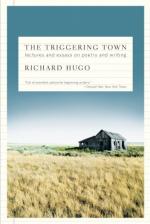
|
| Name: _________________________ | Period: ___________________ |
This test consists of 15 multiple choice questions and 5 short answer questions.
Multiple Choice Questions
1. Who does the British colonel remind Hugo of?
(a) Humphrey Bogart.
(b) Herbert Marshall.
(c) John Wayne.
(d) W.C. Fields.
2. Hugo states that when he was in graduate school, a published scholar who wrote clearly was referred to as a _____.
(a) Popularizer.
(b) Fascist.
(c) Philistine.
(d) Communist.
3. Which famous poet does Hugo say embodies a self superior to the self during the writing of a poem?
(a) Hardy.
(b) Ginsberg.
(c) Valery.
(d) Roethke.
4. What does Hugo call the tearing down of buildings, the building of new housing, etc., as being one problem for modern poets?
(a) Vapid consumerism.
(b) Wholesale changes.
(c) Class deterioration.
(d) Rapid dehumanization.
5. Hugo suggests that with the accumulated losses of knowns, the imagination is faced with the problem of preserving the world through _____.
(a) Internalization.
(b) Calculation.
(c) Externalization.
(d) Reiteration.
6. In which town does Hugo experience what his psychoanalyst calls a moment of surrender?
(a) Hamburg.
(b) Spinazzola.
(c) Vienna.
(d) Lyon.
7. What is the name of the bombardier that attended Stanford University for a year or two?
(a) Bob Mills.
(b) Barry McCormack.
(c) Jeffrey Calhoun.
(d) John Seagal.
8. Whose coarse teasing and ridicule does Hugo say the poet must endure to be his beautiful self?
(a) The lower self's.
(b) Philistine sailors'.
(c) Uneducated fools'.
(d) Dynastic youth's.
9. What is the name of the bush that grows wild in the Pacific Northwest that Hugo uses as a local noun?
(a) Royal purple.
(b) Salmonberry.
(c) Salal.
(d) Butterfly.
10. Hugo believes that worthwhile things can't be _____.
(a) Carried out.
(b) Defined.
(c) Justified.
(d) Forsaken.
11. What other types of writing does Hugo say are already in English departments, making them the logical place to teach creative writing?
(a) Critical and expository.
(b) Technical and dramatic.
(c) Comedic and journalistic.
(d) Conceptual and fictional.
12. Hugo observes that the three prostitutes look so scroungy that one might contract VD just ____.
(a) Touching their doorknob.
(b) Saying hello.
(c) Looking at their photo.
(d) Walking past them.
13. Hugo guesses that ____ of his ex-students are now publishing.
(a) All.
(b) Ten.
(c) Over a hundred.
(d) Forty.
14. Which short story of Hemingway's has the protagonist, Krebs?
(a) "Soldier's Home".
(b) An African Story".
(c) "Summer People".
(d) "The Last Good Country".
15. Where is Captain Joel O. Moe from?
(a) West Virginia.
(b) North Dakota.
(c) North Carolina.
(d) Maryland.
Short Answer Questions
1. Hugo is distrustful of Eliot and Roethke because late in their careers the announced that they were _____.
2. What word does Hugo say should only be used as a transitive verb for at least fifteen years?
3. Where has Hugo worked that he says had little hostility between creative writers and academics?
4. What is the poetry term for a rhythmic or syntactic pause at the end of a line of poetry?
5. Which famous poet does Hugo say informs and fills another body during the writing of a poem?
|
This section contains 443 words (approx. 2 pages at 300 words per page) |

|




